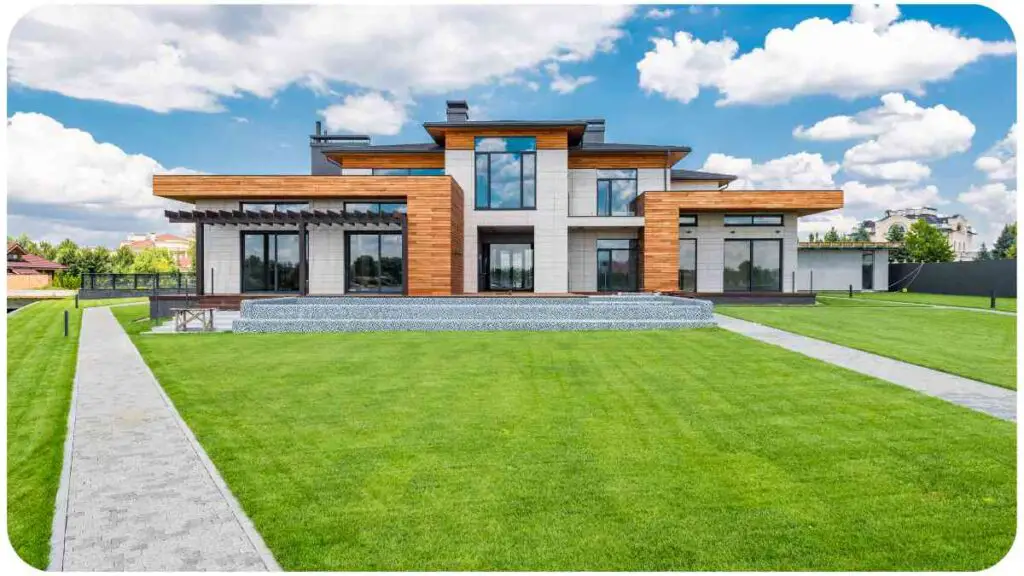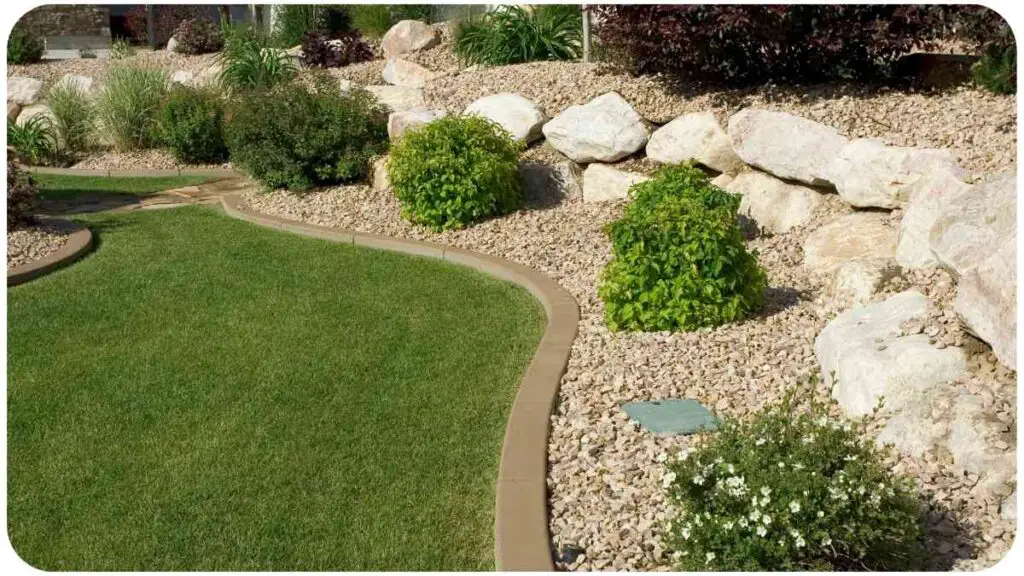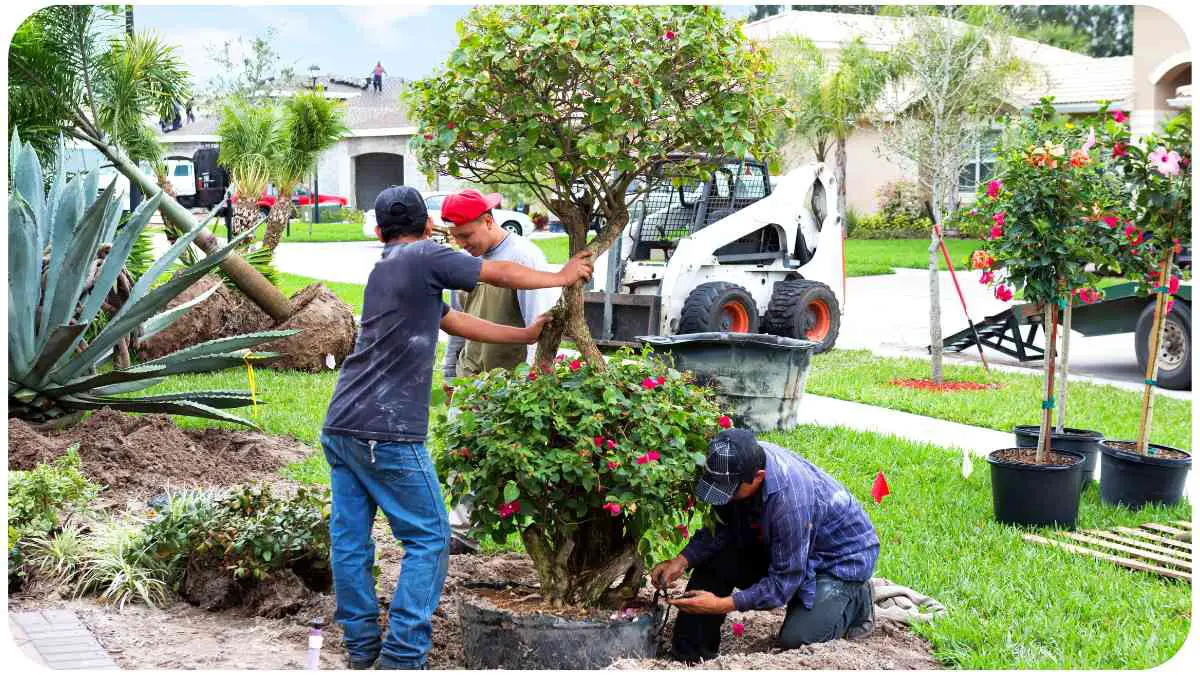Landscaping a sloping front yard can be a daunting task, but with the right approach and understanding, it can transform into a beautiful and functional outdoor space. In this guide, we’ll delve into the intricacies of landscaping sloping terrain, offering practical tips and expert insights to help you navigate this unique challenge seamlessly.
| Takeaways |
|---|
| Assess the slope accurately to inform your landscaping decisions |
| Design terraces and retaining walls to manage the slope |
| Choose suitable plants and materials for sloping terrain |
| Implement proper drainage solutions to prevent erosion |
| Incorporate decorative features and lighting for aesthetics |
| Regular maintenance is key to preserving the landscape’s beauty |
2. Assessing the Slope
Before diving into the landscaping process, it’s crucial to assess the slope of your front yard accurately. Understanding the gradient will dictate the design and construction methods you’ll employ. Here’s a handy table outlining common slope gradients and their characteristics:
Landscaping a sloping front yard requires creativity and expertise to overcome challenges. With proper planning and techniques, you can transform your sloping front yard into a beautiful outdoor space that enhances your home’s appeal.
Table: Common Slope Gradients and Their Characteristics
| Slope Gradient | Characteristics |
|---|---|
| Gentle (0-10%) | Easily walkable, minimal erosion risk |
| Moderate (10-20%) | Moderate difficulty for walking, moderate erosion risk |
| Steep (20-40%) | Challenging to walk, high erosion risk |
| Severe (>40%) | Unsafe for walking, extreme erosion risk |
Understanding the slope gradient will inform your landscaping decisions, from choosing appropriate plants to building retaining walls.
3. Designing Your Sloping Front Yard

Once you’ve assessed the slope, it’s time to envision the layout of your sloping front yard. Designing with the natural contours of the land in mind will not only enhance the aesthetics but also improve functionality and sustainability. Here, we’ll explore various design considerations and suitable plant options for sloping terrain:
Your front yard holds immense potential for outdoor enjoyment and relaxation. Explore creative ideas to maximize the potential of your front yard and create a welcoming environment for family and guests to gather.
Table: Plants Suitable for Sloping Terrain
| Plant | Characteristics |
|---|---|
| Creeping Juniper | Low-growing, drought-tolerant, erosion control |
| Lavender | Fragrant, drought-tolerant, adds color |
| Ornamental Grasses | Erosion control, low maintenance, texture |
| Groundcovers | Spreads quickly, erosion control, variety of colors |
Choosing plants that thrive in sloping conditions is essential for long-term success. Consider factors like soil type, sunlight exposure, and water availability when selecting your plant palette.
Now, let’s move on to the construction phase.
4. Building Retaining Walls
Retaining walls are a vital component of landscaping a sloping front yard, helping to prevent soil erosion and create level terraces for planting and relaxation areas. When deciding on the material for your retaining walls, consider factors such as durability, aesthetics, and cost:
Table: Comparing Retaining Wall Materials
| Material | Pros | Cons |
|---|---|---|
| Concrete | Durable, versatile, customizable designs | Expensive, requires professional installation |
| Timber | Natural appearance, easy to work with | Prone to rot, shorter lifespan |
| Stone | Aesthetic appeal, long-lasting | Expensive, labor-intensive installation |
| Gabion | Modern look, eco-friendly | Requires maintenance, limited design options |
Each material has its advantages and drawbacks, so choose one that aligns with your budget, style preferences, and maintenance capabilities.
5. Creating Terraces
Terracing is an effective way to manage a sloping front yard, providing level areas for planting, seating, and outdoor activities. The design of your terraces will depend on the slope gradient and available space. Let’s explore the pros and cons of different terrace designs:
Creating a drought-resistant front yard is essential for water conservation and sustainability. Learn effective strategies and tips to build a drought-resistant front yard that thrives even in dry conditions.
Table: Pros and Cons of Different Terrace Designs
| Terrace Design | Pros | Cons |
|---|---|---|
| Raised Beds | Easy to construct, improves drainage | Limited planting space, requires maintenance |
| Stone Walls | Durable, natural appearance | Labor-intensive installation, expensive |
| Timber Steps | Versatile, blends well with natural surroundings | Prone to rot, periodic maintenance |
| Gabion Baskets | Modern look, allows for creative designs | Requires filling, limited planting options |
Choosing the right terrace design will depend on your aesthetic preferences, budget, and landscaping goals.
6. Incorporating Pathways and Steps
Pathways and steps are essential elements in a sloping front yard, providing access between different levels and enhancing the overall design. When selecting materials for pathways and steps, consider factors such as durability, safety, and aesthetic appeal:
Considering building a driveway in your front yard? Understand the process, regulations, and factors involved in installing a driveway to enhance accessibility and curb appeal of your property.
Table: Materials Comparison for Pathways and Steps
| Material | Pros | Cons |
|---|---|---|
| Flagstone | Natural appearance, non-slip surface | Expensive, labor-intensive installation |
| Gravel | Low cost, easy to install | Requires regular maintenance, can be uneven |
| Concrete | Versatile, customizable designs | Prone to cracking, may become slippery when wet |
| Wood | Warm appearance, blends well with nature | Requires periodic maintenance, prone to rot |
Selecting the right materials for pathways and steps is crucial for both functionality and aesthetics.
7. Selecting the Right Plants

Choosing the appropriate plants for your sloping front yard is crucial for creating a thriving and visually appealing landscape. Consider factors such as sunlight exposure, soil type, and water requirements when selecting plants. Let’s examine the sunlight and water requirements of popular plants suitable for sloping terrain:
Table: Sunlight and Water Requirements of Popular Slope Plants
| Plant | Sunlight Requirements | Water Requirements |
|---|---|---|
| Creeping Phlox | Full sun to partial shade | Moderate |
| Sedum | Full sun | Low |
| Daylilies | Full sun to partial shade | Low to moderate |
| Purple Coneflower | Full sun | Low to moderate |
Choosing plants that match the environmental conditions of your sloping yard will promote healthy growth and reduce maintenance efforts.
Resodding your front lawn can breathe new life into your outdoor space. Discover the cost factors and considerations involved in resodding your front lawn to achieve a lush and vibrant yard that enhances your home’s beauty.
8. Ensuring Proper Drainage
Effective drainage is essential for preventing erosion, waterlogging, and other issues in sloping front yards. Implementing appropriate drainage solutions will help maintain the integrity of your landscape design. Here are some common drainage solutions for sloping yards:
Table: Drainage Solutions for Sloping Yards
| Drainage Solution | Description |
|---|---|
| French Drains | Underground drainage system to divert water away |
| Swales | Shallow depressions designed to channel water |
| Terracing | Creates level areas to prevent water runoff |
| Permeable Paving | Allows water to penetrate through, reducing runoff |
By incorporating these drainage solutions into your landscaping plan, you can mitigate water-related issues and preserve the beauty of your sloping front yard.
9. Adding Decorative Features
Incorporating decorative elements into your sloping front yard can elevate its aesthetic appeal and create focal points. From sculptures to water features, there are numerous options to enhance the beauty of your landscape. Here are some ideas for decorative features in sloping yards:
Table: Ideas for Decorative Features in Sloping Yards
| Decorative Feature | Description |
|---|---|
| Sculptures | Artistic sculptures placed strategically throughout |
| Water Features | Fountains, ponds, or cascades to add tranquility |
| Retaining Wall Art | Mural paintings or mosaic designs on retaining walls |
| Garden Ornaments | Statues, gazing balls, or birdbaths for added charm |
Integrating decorative features into your sloping yard design adds personality and creates visual interest.
10. Considering Lighting Options
Proper lighting can transform your sloping front yard into a captivating outdoor space, extending its usability well into the evening hours. From highlighting architectural features to enhancing safety, lighting plays a crucial role in landscaping. Here are various types of lighting options suitable for sloping yards:
Table: Types of Lighting for Sloping Yards
| Lighting Type | Description |
|---|---|
| Path Lights | Illuminates pathways and steps for safety |
| Uplighting | Highlights trees, shrubs, and architectural elements |
| Spotlights | Directs focused light on specific features |
| Downlighting | Mounts lights above to cast a downward glow |
Choosing the right lighting fixtures and placement can accentuate the beauty of your landscape while providing functionality and safety.
11. Maintaining Your Sloping Front Yard

Regular maintenance is key to preserving the beauty and functionality of your sloping front yard. By implementing a seasonal maintenance routine, you can ensure that your landscape remains healthy and vibrant throughout the year. Here’s a seasonal maintenance checklist for sloping yards:
Table: Seasonal Maintenance Checklist for Sloping Yards
| Season | Maintenance Tasks |
|---|---|
| Spring | – Prune overgrown shrubs and trees<br>- Remove debris and weeds<br>- Check and repair retaining walls and terraces |
| Summer | – Water plants deeply during dry spells<br>- Monitor for erosion and drainage issues<br>- Mulch to retain moisture and control weeds |
| Fall | – Clean gutters and downspouts to prevent water buildup<br>- Plant new shrubs and perennials<br>- Inspect and repair lighting fixtures |
| Winter | – Protect plants from frost and freezing temperatures<br>- Check drainage systems for blockages<br>- Store outdoor furniture and decor |
Adhering to a regular maintenance schedule will help keep your sloping front yard looking its best year-round.
12. Conclusion
Landscaping a sloping front yard presents unique challenges, but with careful planning and execution, it can be transformed into a stunning outdoor oasis. By assessing the slope, designing terraces, incorporating proper drainage, selecting suitable plants, and adding decorative features and lighting, you can create a beautiful and functional landscape that enhances the curb appeal of your home.
Remember to prioritize maintenance to ensure the longevity and health of your sloping yard. With attention to detail and regular upkeep, you can enjoy your landscaped front yard for years to come, showcasing the beauty of nature and your creative touch.
Further Reading
- Garden Design: Hillside Landscaping: Explore tips and ideas for landscaping a sloping terrain, from terracing to plant selection.
- Harmony in the Garden: Transforming a Sloping Front Garden: Gain insights into the process of transforming a sloping front garden into a beautiful and functional outdoor space.
- The Spruce: Hillside Landscaping Ideas: Discover creative and practical landscaping ideas for hillside gardens, including erosion control and plant choices.
FAQs
Can I tackle landscaping a sloping front yard on my own?
Yes, with careful planning and research, homeowners can successfully tackle landscaping a sloping front yard. However, hiring a professional landscaper may ensure proper execution and adherence to local regulations.
How can I prevent erosion in my sloping front yard?
Implementing proper drainage solutions, such as French drains and swales, along with strategically placed retaining walls and terraces, can help mitigate erosion.
What are some low-maintenance plant options for sloping yards?
Groundcovers like Creeping Juniper and Ornamental Grasses, along with drought-tolerant perennials like Sedum and Lavender, are excellent choices for low-maintenance landscaping.
What lighting options are suitable for sloping yards?
Path lights, uplighting, spotlights, and downlighting are popular lighting options for sloping yards, enhancing both aesthetics and safety.
How often should I perform maintenance on my sloping front yard?
Regular maintenance is essential for preserving the beauty and functionality of a sloping front yard. Tasks such as pruning, weeding, and monitoring drainage systems should be performed seasonally for optimal results.

Hi! My name is Hellen James, and I’m here to help you with your home-maintenance needs. Whether it’s building a better yard or just trying to fix a garden—I can show you how.


